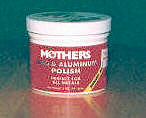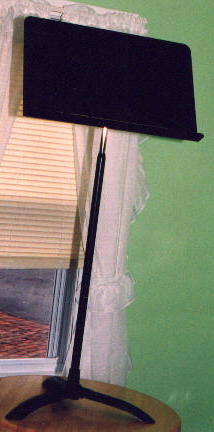

This is a picture
of the Intellitouch tuner from Onboard Research. It clamps onto your peghead,
pot, or dowel stick and gives readouts of Standard A-440, or you can customize
your own tuning references. 3 arrows on each side of the note you are trying
to tune to indicates you are in tune. Sometimes, you have to move it around
on your banjo to get it to read right. It is great when trying to tune
up in a group of other players. It relies on vibrations and not sound waves,
so other people tuning does NOT interfere. $50-70.
Also pictured here
is a standard G tuning, Banjo pitch pipe. Seems to change pitch a little,
depending on how big a blow hard, I mean how hard you blow into it. I'd
rather tune by ear, or use the Intellitouch, myself...$6-10

This is Fast Fret,
by GHS. It comes in stick form, and is applied with this wooden handled
applicator. It is good to help your fingers slide along the neck in times
of high humidity. It can also be applied to the strings to clean them and
let you slide easier. Claims to not soil or stain or damage the finish.

This is a jar of "Mothers Mag & Aluminum Polish." It claims to be perfect for all metals. I use it on all of my nickel plated parts and it works great.You just apply a small amount with a terry cloth rag and rub the polish in until a black residue appears. Then you buff it out with a clean terry cloth rag.(About $5.00)Mothers is available at almost any hardware and automotive store. Also good is a product called Simichrome Polish from Germany. The Vermont Country store carries this product. (Phone orders: 1-802-362-8440) ($12.90 for 2 1.76 ounce tubes)

This is Homer Formby's "Lemon Oil Furniture Treatment." I use it on the back of the neck to clean it and restore the natural oils. I also use it on the peg head and to clean the fingerboard. I have never had a problem using this on my banjos and dulcimer.You just put some on a clean cloth and rub it on until it no longer absorbs, then wipe clean. ($4.00-8 oz.)

On the left is a banjo head wrench, used to tighten the mylar/plastic, calf skin, or a Fibreskyn banjo head. Depending on what type of sound you are looking to attain, determines how tight you set the head. Next in the center is a Shubbs style capo. ($15-20) It is a good capo, but the little black rubber piece wears out and sometimes slips off and it has to be readjusted for up and down the neck. On the right is the Kyser capo, which is spring loaded. You just squeeze the trigger and open it as wide as you want, It also clips onto the peghead very handily when not in use. For the price, ($12-15) and ease of use, this is the capo I use the most.

This is an adjustable
footrest.(Around $15) I use it under my left foot to raise my leg up to
achieve the angle that I want my banjo to be set at when playing. I set
the banjo pot, between my thighs and have it resting with most of the weight
of the pot and neck on my left thigh. It is angled so the peg head is almost
perpendicular with my left shoulder. Works fine for me like this. Like
all things in the banjo world, do what feels the most comfortable and natural
for you, as long as it doesn't adversely affect your playing. Experiment
until you find a comfortable spot for the banjo to rest.

This is the heavy
duty music stand. It does not fall over from the slightest breeze, or collapse
under the weight of a couple of books of tab. I have tried the flimsy aluminum
fold up stands and they just don't cut the mustard. This one although not
real portable, it is sturdy and should last a lifetime. ($35-45)

This is a metronome.
It is an essential tool for the beginner and professional player. It is
by using this that we learn to keep time and to play on the beat. It is
hard to get used to playing along with this gadget, but once you do you
will notice your timing and playing get better and better. This one makes
a tic-tic sound and also has a pulsating light instead, if the tic-tic
starts to drive you nuts. Also, it comes with an earplug in case your playing
is louder than the metronome. ($12-15)
